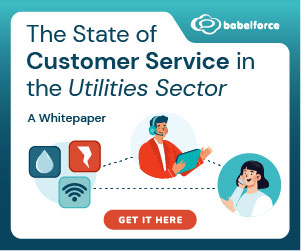Sunny Dhami of RingCentral shares his recommended customer retention strategies, after defining the measure and demonstrating how it can be calculated.
Do you want to know the best way to grow a business?
Most entrepreneurs assume that the answer is to have the best products or offer the most competitive prices. However, the truth is that your price tag and feature set are just two small parts of the puzzle.
In 2020, and the years ahead, the most valuable thing that you can do to make your company more successful is delight and retain your customers.
Once you’ve nailed the work of creating an amazing product and identifying your target market, company growth can really start to take off. However, if you want to keep your business growing and moving in the right direction, then you’ll need to get a customer retention strategy in place.
Fortunately, by the time you’ve finished reading this guide, you’ll know everything you need to know about customer loyalty, retention, and amazing experiences.
What Is Customer Retention?
Before you can begin building the ultimate customer service experience, you’ll need to define customer retention and decide what it really means to your business.
Customer retention is usually presented as a percentage that measures how many customers a company keeps at the end of a set time period. The number of customers that you lose by the end of that period is referred to as ‘churn’.
Because customer retention can be difficult to understand, it’s commonly presented as a formula:

For instance, let’s say you start the year with just 20 customers, and gain five new customers in the first quarter of the year. By the end of the quarter, you might have lost a customer too. Your customer retention formula would look like this:

Once you know your customer retention rate, you can look deeper into why your churned customers left your business. If you can identify patterns or issues that might be driving clients away from your organization, then you can reduce your risk of further churn in the future.
5 Important Customer Retention Metrics
There’s more to a complete customer retention definition than just knowing your customer retention rate.
You also need to understand the metrics that are associated with knowing whether your customers will remain loyal to your business or not.
Customer retention metrics help companies to assess overall customer satisfaction rates and identify opportunities to remove customer roadblocks.
The more customer retention metrics you can collect, the more your sales, marketing, customer service, and even product management teams will benefit. That’s because customer retention metrics help every member of your team to fine-tune their contribution to the customer journey and improve the experiences that they give your user base.
Although there are many different metrics for businesses to keep track of in today’s experience-focused landscape, here are just some of the most important ones to consider.
1. Customer Churn
Customer churn is one of the most straightforward customer retention metrics.
Churn rate refers to the rate at which clients stop interacting with your business. They may have opted out of renewing their subscription with your brand or just stopped buying from you. Either way, you’ve failed to retain that client.
While some churn in your business is natural, it’s important that you avoid letting your rate get too high.
If your annual churn is more than 5%, you may need to evaluate the happiness of your customers and determine how you can improve your customer experience (CX) strategy.
2. Revenue Churn Rate
Your revenue churn rate refers to the percentage of revenue lost from existing customers within a specific period.
For instance, revenue churn might come from order cancellation, plan downgrades, or the loss of a business relationship.
Overall revenue churn provides a bird’s eye view of your customer service experience. However, it’s essential to keep track of why people are spending less on your service or product from an individual level too.
With this in mind, your company should be focused on ensuring that your customers receive the same or an increased level of value from your brand over the years.
3. Existing Customer Revenue Growth Rate
This is one of the many client retention metrics that you’ll need to pay close attention to when you’re growing a successful company.
If your customer revenue growth rate continues to grow, then this indicates that you’re doing a great job with the customer service experience. You’re clearly convincing your customers to continue spending, and even to increase what they spend on your products or services.
On the other hand, a stagnant existing customer rate of growth could be dangerous for your business.
Remember, acquiring a new customer can be four times more expensive to your company than upselling an existing one. Every existing customer you lose harms your bottom line.
4. Repeat Purchase Ratio
The repeat purchase ratio or RPR is the percentage of customers in your community that have returned to purchase something from your company again. This is an excellent indicator of customer loyalty – which is important to the overall customer retention rate that you build over time.
You can apply this metric to things other than product purchases too.
For instance, a repeat purchase ratio can also apply to repeat subscriptions or contract renewals too.
What’s great about these ratios is that you can look into what kinds of customers keep coming back to your company and see if there are any trends. You might even be able to get a better insight into your target customer.
5. Net Promoter Score
Net promoter score (NPS) is probably one of the best-known metrics for customer retention and customer loyalty. NPS quantitatively measures the general satisfaction and loyalty that people feel to your brand.
Once you’ve calculated net promoter score, this will tell you if your customers are content with what you have to offer and are willing to refer your services and products to others.
Also, you can compare your NPS to your revenue growth rate and customer churn rate to predict potential growth for your business.
While no single customer retention metric will guarantee the failure or success of your business, they will give you an insight into how well your company is performing in different areas.
If you see that your NPS is high, for instance, but that your recurring revenue is stagnant, then the issue might not be with your customer service at all but with the product or packages that you’re offering.
The Difference Between Customer Retention and Acquisition
One of the main issues that businesses have with customer retention and retention rates is that they’re not sure whether retention is more or less important than customer acquisition. After all, you need to acquire customers before you can retain them.
Increasing your customer base and finding new sources of revenue for your business is the fastest way to grow your company.
You need to be constantly acquiring new customers with exciting new sales strategies, marketing campaigns, and excellent product offers. However, that doesn’t mean that acquisition is more valuable than customer retention.
Customer acquisition refers to the process of using various methods, including sales and marketing techniques, to attract people to your company and convince them to buy.
On the other hand, customer retention is all about adding customer loyalty and satisfaction into that equation. When you take an acquired customer and cause them to fall in love with your brand thanks to exceptional experiences like excellent upselling and proactive support, you get customer retention.
Customer retention turns the standard client for your business into a repeat customer who will continue to offer you a consistent source of revenue.
At the same time, retained customers are more likely to become advocates for your business too – driving new clients your way.
While both acquired and retained customers are important, retained customers are the ones with the most customer lifetime value (CLV).
When companies refer to customer lifetime value, they’re referring to a prediction of the total profit generated by a customer over a projected period of time.
Calculating this number helps companies to see how valuable each customer is when retained over time. When you look into the numbers presented by CLV, you see just how important a customer retention strategy can be.
For instance, according to Invesp:
- Increasing customer retention rates by 5% increases profits by between 25% and 95%
- The success rate of selling to a customer you already have is between 50% and 70% while the success rate of selling to a new client is only 5-20%
- Acquiring a new customer is five times more expensive than retaining an existing customer
Yet despite these statistics, Invesp also found that 44% of brands still admit that they focus more heavily on customer acquisition, while 18% focus heavily on retention.
What’s the Difference Between Customer Retention and Loyalty?
To explain the value of customer loyalty and retention, it’s important to know the difference between loyalty and retention.
A retained customer is one that continues to buy from your business time and time again. However, just because you’ve got high customer retention, doesn’t necessarily mean that you have high customer loyalty.
Sometimes, customers will purchase from your business because it’s the easiest, most convenient, or cheapest option. That means that you instantly lose your retained customers whenever a new and more attractive offer appears on the market.
Alternatively, if you have exceptional customer retention because of high customer loyalty, your customer will continue to stay with you because they love your service, your product, or the customer experience that they get.
Customer loyalty can be an aspect of customer retention, as loyal customers will often buy from you repeatedly too.
At the same time, however, because a loyal customer is passionate about your brand, they can also help your business to grow in other ways. Loyal customers are more likely to recommend your brand to other customers and advocate for you in your industry.
Establishing customer loyalty in a virtual environment is crucial in an age where customers have endless opportunities to buy from different brands online.
Your customers today have no problem switching to a different vendor if they don’t get what they need from you. It’s important that when you define customer retention for your brand, you focus on getting not just repeat clients, but customers who feel committed to your organization.
The good news? It’s relatively easy to create loyalty in your customers.
One Temkin Group study showed that happy customers are more than five times more likely to repurchase. More importantly, they’re also seven times more likely to forgive your business if it does something wrong.
All you need to do to create loyal and consistent customers is make them happy!
The Importance of Customer Retention
As easy as it is to get carried away focusing on customer acquisition as a new business, it’s crucial that you don’t overlook the importance and benefits of customer loyalty and retention.
Retention is essential to any growing company because it measures not just how successful you are at gaining customers but how successful you can be at keeping those customers satisfied.
At the same time, as we touched on in the section above, a high customer retention rate comes with a ton of ROI.
For instance, retained customers often spend more and buy more often than new customers. They’ve had a chance to see the value of your brand and product, and that means that they keep coming back for more.
At the same time, the satisfied and loyal customers that keep coming back to your business are also more likely to sing your company’s praises. This means that they bring new customers to your brand free of charge. Word of mouth is still the best marketing strategy that any business can leverage.
As more customers continue to rely on the input of their friends and family to decide where to buy, brand advocates are more valuable than ever.
Unfortunately, it isn’t always easy to retain every customer.
3 Common Reasons Why Customers Are Lost
Though various companies are beginning to recognize the value of retained and loyal customers in the modern landscape, brands are still losing clients every day.
According to research from McKinsey and Company, only around 13% of customers say that they’re still loyal to a single brand.
On the other hand, 87% of customers are happy to shop around to find the best deal.
So, what are the main triggers that cause customers to jump ship?
1. Your Customer Service Isn’t Good Enough
There are few things that turn a customer experience sour faster than poor service.
A customer sees your support team as the heart of your business. If your clients can’t rely on your support team to offer the quick assistance that they need when they need it most, then they’ll go elsewhere.
Even if you still have the cheapest product or the widest range of features, today’s customers won’t take the risk of dealing with a company that has a poor customer experience strategy.
To get ahead in the current landscape, you’ll need to:
- Assess the gaps in your service strategy: What kind of support do your customers need that you just aren’t offering right now? Do they need access to chat and video as well as voice calls? Can you answer calls quicker, or route them to the right agents more intelligently?
- Outline better customer service practices: Use your internal audit to find ways of improving your service strategy. Add new systems into your workplace that will allow you to solve problems faster or serve your customers in different ways.
- Support your customer service team: Make sure that the agents responsible for giving exceptional customer service have the tools that they need to make them more efficient, from virtual receptionists to contextual information.
2. Your Business Isn’t Consistent
Consistency breeds trust in the business landscape. Customers know that things that are consistent can be relied upon.
Unfortunately, inconsistent experiences are rife in the current business landscape. This is particularly true as companies try to add new avenues of communication to their contact centre and communication environments.
Today’s customers expect that they will get the same level of quality support from you and your agents whether they’re contacting you in person, speaking to an agent over the phone, or getting in touch via email. Make sure that the end-to-end experience is seamless for your audience.
3. Your Customer Service Strategy Is Complex
Finally, your customers want to be sure that it’ll be easy to get help whenever they need it most. Your audience doesn’t want to wait around for an email response to a query for days at a time because that’s the only method of support that you offer.
When people have urgent questions or issues, they often want to contact your business via phone. That means that you need a strong and reliable phone system in place.
At the same time, there will be occasions when your customers want to solve problems for themselves by visiting an FAQ page or speaking to a chatbot.
Make sure that it’s easy for everyone in your community to get help in a way that’s suitable for them.
7 Strategies for Boosting Customer Retention
Now that you know some of the reasons why people leave your business, it’s time to figure out some ways that you can get them to stay.
There are a huge number of excellent customer retention strategies out there, some more effective than others. Here are just some of the solutions that we think are best for boosting customer retention.
1. Anticipate Your Customers’ Needs
The first thing you can do to improve your customer retention strategy is get to know your target audience.
Assess your user personas and use the information that you have to build a roadmap of their buyer journey.
If you know that your customers usually check your website for information before talking to an agent, maybe you can put a chatbot on your site that will answer their most common questions immediately.
Alternatively, if you think that your customers speaking to your chatbots will need to escalate their conversation to a phone call with one of your agents, put click-to-call on your website.
2. Focus on Reducing Customer Effort
Customer loyalty is built through simple and convenient experiences.
Today’s customers are used to getting what they need instantly. They don’t want to have to wait around on hold to get an answer to their questions.
With that in mind, your customer service strategy should be built on keeping effort levels from your clients as low as possible. For instance:
- Let agents switch channels or add channels to an ongoing interaction to make it easier to share information between a customer and your team.
- Serve customers on the channels that they like most, from chat and video to email and audio.
- Use intelligent systems to route the customer to the right agent first time around, so they spend less time on hold or being transferred.
- Use contextual screen pops to provide agents with information about a customer, so they don’t need to repeat themselves.
3. Upgrade Your Contact Centre Tools
Speaking of using technology to make the lives of your customers easier, you can also upgrade your contact centre tools to support your agents too.
For instance, you could integrate your CRM systems with your contact centre environment, so that your customer service representatives can instantly pull up customer profiles and use them to deliver more personalized experiences to your audience.
No customer wants to have to repeat personal information every time they speak to your business.
Harnessing CRM integrations within your contact centre can reduce the time taken for agents to resolve customer problems too, by ensuring that they have the information that they need on hand.
4. Let Customers Serve Themselves
As the internet has become easier and more accessible for customers to access from a range of environments, we’ve got used to the concept of self-service.
These days, many of your clients will be happy to find answers to any questions that they have about your service or company by themselves, provided that you give them the right information to do so.
Make sure that you bring self-service opportunities into your contact centre strategy so you can help your audience help themselves. This might include intelligent chatbots that can answer questions for your customers and FAQs that they can search to find the answer to their specific query.
Some businesses even offer articles and videos to teach their clients how do to certain things. The more your customers can serve themselves, the more time your agents will have to help the clients that need them.
5. Automate Repetitive Tasks
Your customer service agents are at the heart of your customer retention strategy. If your employees are spending all of their time on repetitive tasks, then they’re not going to be giving the right amount of attention to your clients. Fortunately, modern contact centre solutions like virtual assistants and intelligent IVRs can help with this.
For instance, if you can automate the process of routing customers to the right agent at the best times, then you can save the amount of time that your agents spend moving calls from one person to another. This will help to keep your team members focused and ensure that customers get to the person that they need faster.
6. Encourage Agent collaboration
Team collaboration tools for instant messaging, file sharing and even video conferencing are becoming increasingly valuable in the contact centre environment. That’s because these solutions allow the people in your customer service space to collaborate with each other on delivering better experiences for your audience.
If you have a strong collaboration strategy built into your business, when a customer calls your team with a question that your agent can’t answer, they’ll be able to instantly message a specialist for more information. Your teams can even use their collaboration tools to pull specialists into video chats so they can discuss a customer issue in depth.
Access to collaboration tools will also make it easier for your agents to have access to a central base of important knowledge.
7. Gather and Respond to Feedback
Finally, today’s customers aren’t afraid to talk about the experiences that they have with their favourite and least favourite brands.
Collecting feedback from your clients is one of the easiest ways to develop a strategy for great customer experience in the future.
While not all of the feedback that you get from your customers will be positive, the negative reviews will also tell you where you need to work on your service to improve your retention rates and harness greater loyalty.
At the same time, if you’re using customer retention tools to collect data on calling trends and customers satisfaction rates, you can combine qualitative and quantitative data to get a better overview of the strategies that you need to implement for future success.
The more data you have about your customers and what makes them happy, the better off you’ll be.
Customer Retention Tools
The most common customer retention tool in use today is the contact centre. Your contact centre is the central point of connection between you and your target audience. The more efficient and effective you can make it, the greater your client retention will be.
However, now that more companies are starting to discover the true value of customer experience and loyalty, more tools are appearing to help drive more impressive digital customer experience strategies. Here are just some of the customer retention tools that you might use in 2020 and beyond:
Customer loyalty programmes: Customer loyalty programmes are one of the easiest ways to boost customer retention today. When customers get additional value from your brand, in the way of a VIP rewards programme or points system, it becomes much less likely that they’ll switch to a competitor for their next purchase. With a loyalty programme, brands can make their customers feel special, and encourage higher sales numbers as a result.
Customer analytics tools: Tools for customer analytics are built into your contact centre and communication system. These tools allow you to track things like time to resolution and the number of calls an agent handles each day. Sometimes, tracking the individual interactions that happen in your business can make it easier for you to determine where the friction points and pain points are for your audience.
Survey and feedback systems: One of the easiest ways for any business to find out what a customer thinks about them is through feedback. While you can sometimes collect feedback from the things that customers say to your sales team in passing, it’s much better to have a structured strategy for collecting this information. A request for a rating can be built into your contact centre strategy to help you get an insight into things like satisfaction rates and NPS.
Recording and training: Call recording and training systems are excellent tools for customer experience and retention. When contact centre teams can record calls, they can use conversations with previous customers to train future employees and see where certain agents are going wrong with their discussions. Call recording systems can even be combined with analytics and AI technology to determine trends in customer satisfaction issues.
Agent monitoring tools: Agent monitoring tools in the contact centre allow supervisors and managers in any environment to monitor a conversation between a representative and a client in real time. This means that they can step in and help when a discussion isn’t going in the right direction. The same monitoring tools can also highlight opportunities for further training in the contact centre, and even deliver chances for gamification by allowing agents to compete for better scores.
Artificial intelligence and virtual assistants: While virtual assistants aren’t totally commonplace in the modern workplace, they’re becoming increasingly popular. These tools give extra information and context to agents when they’re in conversations with customers. At the same time, these tools can sometimes offer ideas on how an agent can improve a conversation. Some AI systems come with things like natural language processing and sentiment analysis built in for better in-depth suggestions.
CRM Tools: Customer relationship management (CRM) tools are excellent solutions intended to help businesses keep track of customer journeys. When combined with contact centre tools and other services, CRM systems can give agents and service representatives access to the information they need to offer personalized services to their customers.
CRM and Customer Retention
Perhaps the most common tool that businesses rely on for customer retention and better customer experience strategies these days is the CRM tool.
Customer relationship management tools like Zoho and Salesforce allow businesses to deepen their relationships with customers and colleagues by giving them in-depth profiles to work with during every interaction.
By 2021, Gartner predicts that CRM technology will be the largest revenue spending area for enterprise software in the world.
In the modern customer experience landscape, businesses can combine their CRM technology with a contact centre solution like the one available from RingCentral through the cloud. This makes it easier for customer agents to access insightful information about the customers that they’re serving and personalize experiences according to that client’s needs.
With CRM integration, agents can track information about a customer across channels, and even update a customer’s profile with new information about any issues that they may be having that need to be checked up on in the future.
In the future, contact centre systems aligned with CRM tools will make it easier to provide a more complex CX solution and enhance customer retention in every business landscape.
Get Ready for Better Customer Retention
Customer acquisition is just the first step in building a successful company.
Once you’ve developed the product or service that attracts your clients to your brand, the next step is convincing your audience that they want to stick with you in the long term.
Retained customers are more valuable than your standard acquired customers, offering you years of high customer lifetime value.

Sunny Dhami
At the same time, it’s these dedicated clients that will help your business to grow the most, through things like word-of-mouth marketing and brand advocacy.
As we continue to move forward into the age of customer experience, it’s essential to ensure that your business has what it takes to delight your customer at every stage of their journey.
Whether your client is contacting your sales team to make a purchase or your service team for help, exceptional experiences are the key to better brand loyalty and valuable retained customers.
Author: Robyn Coppell
Published On: 24th Jan 2020 - Last modified: 18th May 2021
Read more about - Guest Blogs, RingCentral















